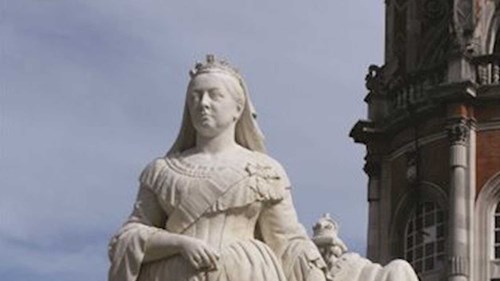Queen Victoria, about 1883

Count Gleichen (Prince Victor of Hohenlohe-Langenburg) (1833 – 1891)
Marble
The creator of this statue, Count Gleichen, was the half-nephew of Queen Victoria. Born at Langenburg in Württemberg, Germany, he ran away from boarding school at the age of fourteen, which led Queen Victoria to offer him a place in the British Navy. He quickly rose through the ranks, but was forced to retire on half-pay in 1866 due to poor health.
After the failure of the bank which contained his savings, he turned to sculpture as a serious pursuit. Queen Victoria granted him a suite of rooms at St James’ Palace to use as his studio and he trained for three years under William Theed, one of her favourite sculptors. Despite initial hostility from other sculptors due to his privileged position as a member of the Royal Family, he soon proved he was a talented artist. He was well-regarded for his portrait busts, and he sculpted numerous famous figures including Garibaldi, Benjamin Disraeli, and Mary Seacole – a Jamaican nurse who met Count Gleichen during the Crimean War.
Thomas Holloway’s brother-in-law, George Martin-Holloway, commissioned this statue along with the statue of Thomas and Jane Holloway (situated in the South Quad). It was unveiled by Princess Christian, Queen Victoria’s third daughter, in a ceremony in December 1887. Contemporary critics praised the sculpture for being ‘a faithful portrait and a charming work of art.’




















